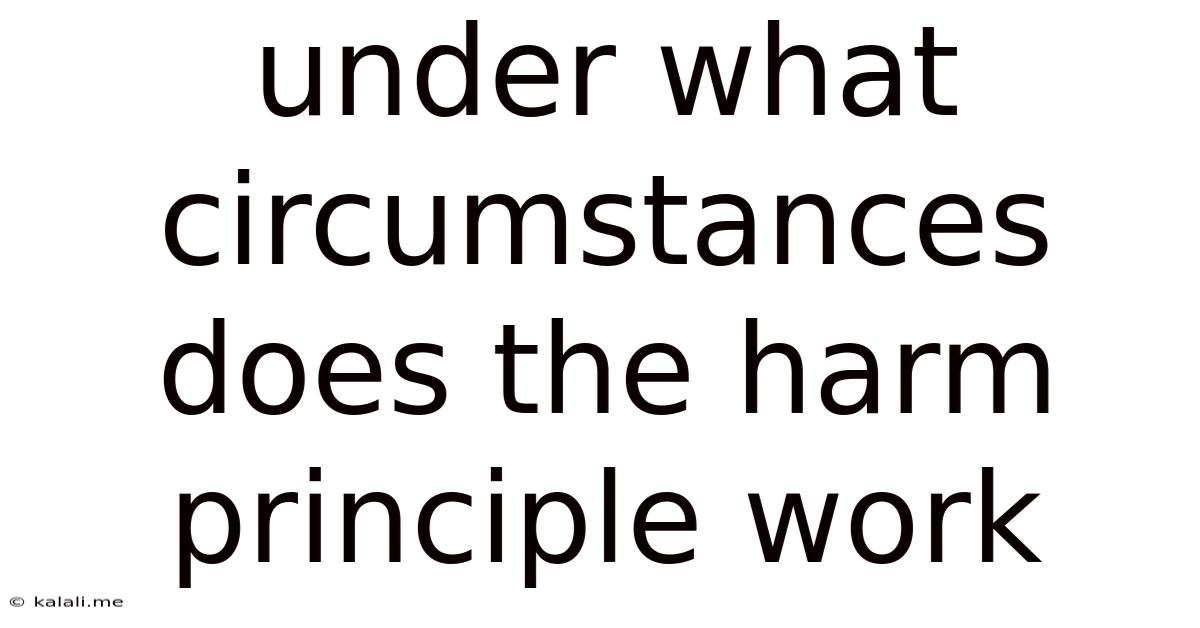Under What Circumstances Does The Harm Principle Work
Kalali
Jun 10, 2025 · 3 min read

Table of Contents
Under What Circumstances Does the Harm Principle Work?
The harm principle, famously articulated by John Stuart Mill in On Liberty, asserts that the only justification for limiting individual liberty is to prevent harm to others. This seemingly straightforward principle, however, is far more nuanced and complex than it initially appears. Its application hinges on a careful consideration of various factors, and its effectiveness is often debated. This article explores the circumstances under which the harm principle successfully operates and the limitations it faces.
Defining Harm and Its Scope:
The core challenge lies in defining "harm." Is it solely physical injury, or does it encompass emotional distress, economic loss, or offense? Mill himself acknowledged the difficulty, suggesting that harm primarily refers to actions that violate the rights or interests of others. However, the interpretation of "rights" and "interests" remains subjective and context-dependent.
- Physical Harm: This is the most straightforward application of the harm principle. Assault, battery, and murder clearly fall under this category, justifying state intervention.
- Psychological Harm: This area is more contentious. While severe forms of harassment or bullying undeniably cause harm, less severe forms raise questions about the appropriate level of state intervention. Where do we draw the line between offensive speech and psychologically harmful speech?
- Economic Harm: Fraud, theft, and other economic crimes clearly violate the harm principle. However, the line blurs with issues of market regulation and competition. Does unfair competition constitute harm?
- Moral Harm: This is the most contested area. Many argue that the state should not intervene in matters of personal morality, even if certain actions are deemed morally reprehensible. This encompasses debates on drug use, prostitution, and gambling.
Limitations and Challenges to the Harm Principle:
The harm principle is not a universally accepted or easily applied standard. Several challenges complicate its practical implementation:
- Difficulties in Prediction: It's often difficult to predict with certainty whether a particular action will actually cause harm. The potential for harm may be remote or speculative, making it difficult to justify preemptive intervention.
- Subjectivity of Harm: What constitutes "harm" is subjective and culturally influenced. What one person finds offensive, another may find acceptable or even beneficial.
- Paternalism vs. Liberty: The line between protecting individuals from self-harm and respecting their autonomy is often blurred. Paternalistic interventions, which restrict individual liberty for their own good, are problematic even if intended to prevent harm to themselves.
- The Problem of Offense: The harm principle often struggles to address actions that cause offense but not necessarily direct harm. Freedom of expression often clashes with the desire to protect individuals from offensive speech or behavior.
- Collective vs. Individual Harm: Some actions might not directly harm individuals but could harm society as a whole (e.g., environmental pollution). The harm principle's focus on individual harm makes it less applicable to such situations.
Circumstances Where the Harm Principle Works Best:
The harm principle works most effectively in situations where:
- Harm is clear and demonstrable: The action directly causes physical injury or significant financial loss to another person.
- Causation is direct and evident: A clear link exists between the action and the harm suffered.
- Harm outweighs the limitation of liberty: The restriction on individual freedom is proportionate to the harm prevented.
- Alternative solutions are insufficient: Less restrictive measures haven't been effective in preventing the harm.
Conclusion:
The harm principle provides a valuable framework for evaluating the limits of individual liberty, but it's not a simple solution to all ethical and legal dilemmas. Its successful application requires careful consideration of the context, a nuanced understanding of "harm," and a balance between protecting individual autonomy and preventing harm to others. The debate over its scope and application will undoubtedly continue as societies grapple with evolving ethical and social challenges.
Latest Posts
Latest Posts
-
What Grade Level Do You Learn Algebra 1
Jul 01, 2025
-
How Long Ago Was The 16th Century
Jul 01, 2025
-
How Many Inches Are In 4 Yards
Jul 01, 2025
-
How Many Calories In A Pound Of Hamburger
Jul 01, 2025
-
How Many Ounces Are In 9 Pounds
Jul 01, 2025
Related Post
Thank you for visiting our website which covers about Under What Circumstances Does The Harm Principle Work . We hope the information provided has been useful to you. Feel free to contact us if you have any questions or need further assistance. See you next time and don't miss to bookmark.